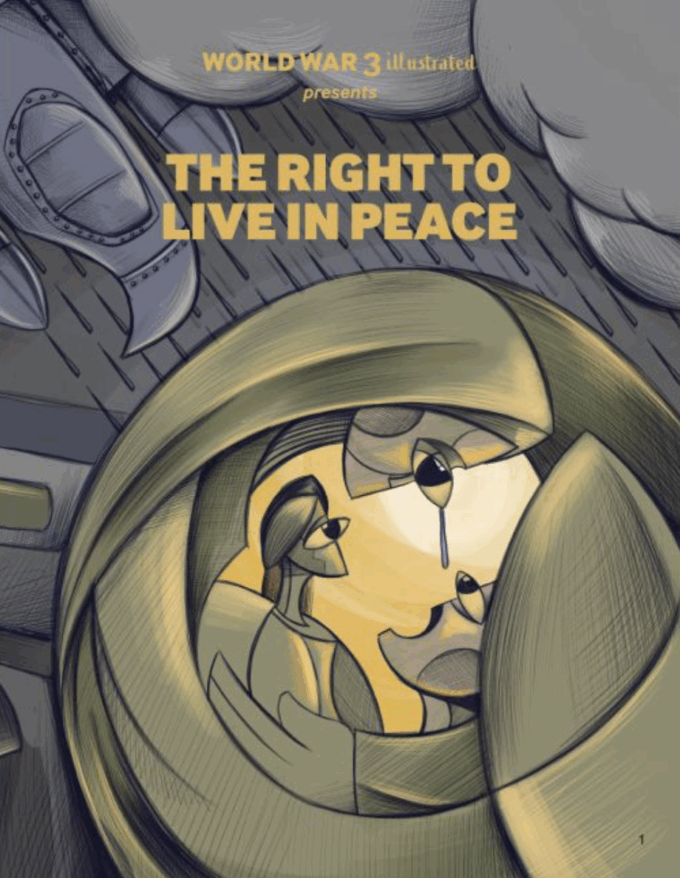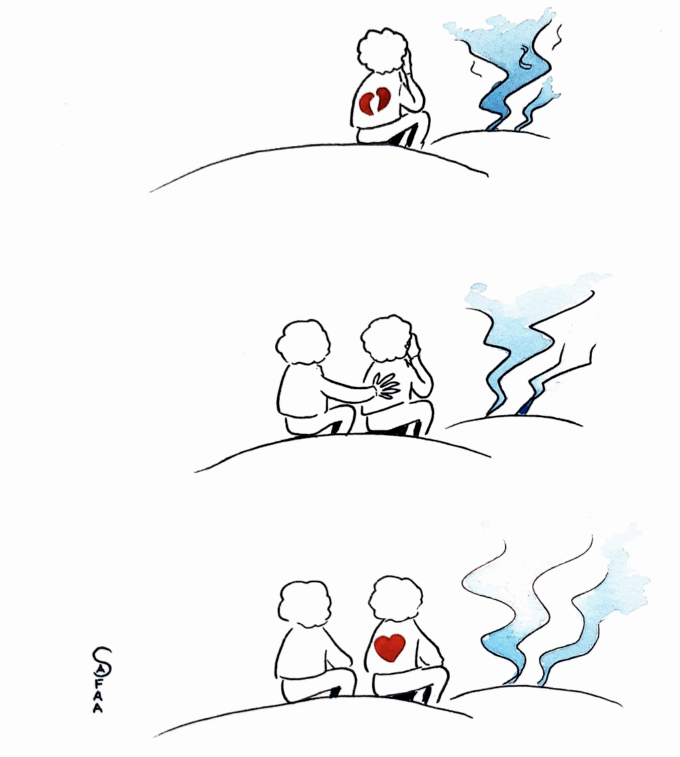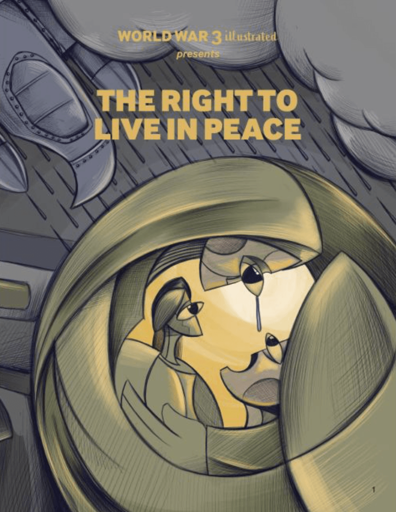Gaza and “The Right to Live in Peace”: World War 3 Illustrated #55.
AK Press, 2025. 224pp, $15.00
Founded in 1979 by Seth Tobocman and Peter Kuper as an ongoing anthology of radical comics, “WW3” has been on the job ever since, full of politics and art mixed, with more artists and more young artists, than anywhere else in the comics world. This time, the collective editorial group includes up and coming Palestinian comic artist Mohammad Sabaaneh, and as well, a host of Palestinian contributors.
This time around, the stars shine. “Never Again!..and Again…And Again,” by Joe Sacco and Art Spiegelman, has the famed pair sometimes in Gaza itself, sometimes apparently in Art’s studio in New York, ruminating Genocide (Art calls it “ethnic cleansing” or “genocidish”), the long history of anti-Semitism, the creation of Israel captured in a single act of a comic panel. An imagined sales agent offers Jewish immigrants of 1948 “an apartment without people, for a people without an apartment,” effectively banishing the ghosts of Palestinian children who had lived there.
The strip ends with an apocalypse and the two artists holding banners that spell out “Never Again, for Anyone!” These pages will live for centuries. 
But to highlight the famous artists threatens to brush aside the others and the truly global character of this creation, and most notably, the contribution of Arab artists and storytellers themselves. Here, for instance, we find a story by, and an old interview with Naji al-Ali, one of the truly great comic artists of the Middle Eastern world and culture. An unbounded satirist hated by Israeli officials but also by the powerful in Arab states’ rulers, Naji was assassinated on a street in London in 1987. His work, his ability to capture the tragedies of Palestinian life, speak for themselves.
Jordan Worley, an American radical comic artist, explores in “The Red Heifer,” the history of evangelical fanaticism built up mainly in the US. Erik Jacobson and Teo Suzuki collaborate on “Police Abolition and Palestinian Solidarity,” how dissent in the US is increasingly “policed” as in Israel, for the logical reason that so many US police have been trained in “crowd control” by the Israelis. An especially grim thought amid the ICE raids.
Seth Tobocman continues his series on his struggles with his family, normal Jewish Americans of a generation especially protective of Israel. “Talking Politics With Mom” reminds us of many casual family conversations becoming un-casual, when Israel and the horrors of Gaza are referenced, something more vivid these days. For Seth’s parents, some of whose relatives disappeared in Europe, Israel is the place of new, strong Jews free of anti-Semitic stereotypes also experienced in their young lives in the US. His mother struggles to understand but the barriers are too great. He concludes the strip by telling us that it is years since his mother’s passing, and he is still talking to her—in his mind, perhaps still thinking, subconsciously, that he can win her over to better views.
Ethan Heitner, another steady member of the WW3 group, poses in “Questions for My Family,” that is, naturally, his JEWISH family. The last page reads, “If you need Palestinians to be utterly submissive, to accept total surrender in order for you to feel safe…Can I still love you?” (p.191). He’s not the only one.
Ben Katchor, MacArthur awardee and famed comics art teacher at Parsons, makes an unusual appearance in WW3 with his own street experiences around Columbia and downtown. Even the old contradictions of the upper class, Upper West Side Jews, so different from the less privileged downtown, come back into view. Nothing ever disappears completely, even with the passing of generations: this is Katchor’s familiar message in his work. The extraordinary mass-murderous violence of the Israelis adds one new element.
Nicole Schulman, longtime WW3 group and co-editor of Wobblies!, the centenary history of the IWW, eloquently offers a story in prose plus drawings, of “Hamsa,” etched upon walls of ancient caves and presumably by the women of Mesopotamia. Spreading across a diaspora, it reached even the Sephardic populations of Iberia, a symbol of hoped-for protection under Moorish rule. Schulman closes, “Now the divine feminine hand of protection has been pushed aside by the masculine fists of war. Hands that should be used for caring and healing are being used for oppression and violence.” (p.197). But perhaps they can heal, with mutual defense of “Fatima and Miriam,” Palestinians and Jews, because survival has become impossible otherwise.
Among the most remarkable contributions here must be those from the Arabic Middle East. Some are abstract, not even a story as such, mainly glimpses of horrors.

Thus Safaa Awad, a Palestinian from Gaza (source of the illustration above), a contributor to regional publications and most recently, her own ongoing book, shared on the web, Safaa and the Tent: the Diaries of a Palestinian Pain, Witnessed in Silence by the World.
Thus, Faris Saba and Hiba Hamilton give us eight pages without title, a dread tale of Rabbinical fanaticism, of earth movers—presumably preparing the way for Jewish settlements in the West Bank—unearthing the bodies of the Palestinian children murdered. Unforgettable pages.
Dania Omari offers a comic with few words, about her life, and the WW3 editors have chosen to publish it in a format natural to her: Right to Left, p.223 “backward” to p.207. She is homeless in Ramallah, in the sense of being a refugee, very fortunate to be able to work and study legally in Israel, yet separated from Jerusalem by a forbidding wall, and of course facing the constant threat of official and unofficial Israeli violence.
Other Palestinian/Arab contributors include Shahd Alshamali, Amal Al Nakhala, Nidal Elkhairy, Fuad Alymani, Sohail Salem, Wahaj Bai Moufleh and Misara Baroud. Quite a stunning contribution to comic art, in all.
Some of the pages are painful to look at. But the art and the narration will live with me for a long time.
The post “The Right to Live in Peace” appeared first on CounterPunch.org.
From CounterPunch.org via this RSS feed


